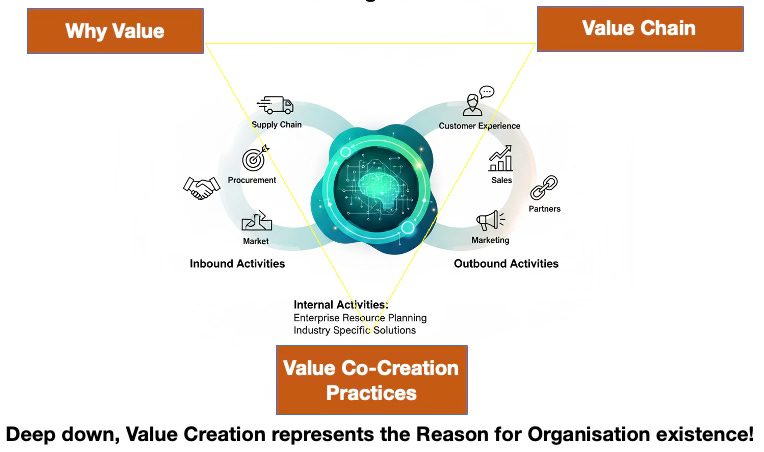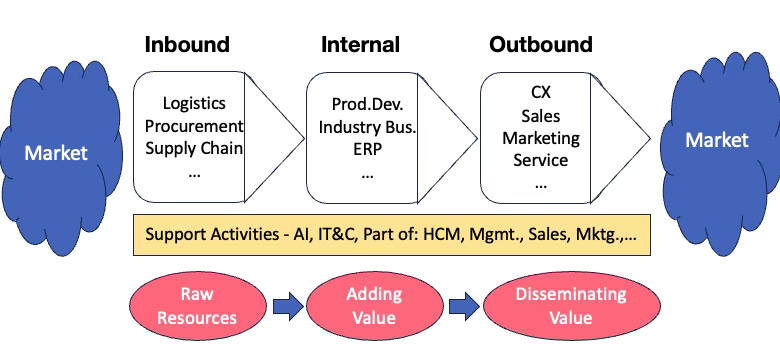3.2 — Value Co-Creation Practices
Transforming the Value Chain into a Collaborative System
Re-thinking the Value Chain
Traditional business models define value creation as a linear process: Inbound → Internal → Outbound.
Inputs are sourced, transformed internally, and delivered to customers. In an Alive Organisation, this linear model evolves into a continuous value system in which every stage—sourcing, production, and delivery—operates as a learning partnership.
Value is not pushed along the chain, but co-created across it through feedback, transparency, and shared purpose.
1. Inbound – Partnership and Supply Ecosystems
Inbound covers suppliers, logistics, and sourcing activities. In a co-creative model, suppliers are treated as strategic partners rather than transactional vendors.
Key practices include:
Joint Design and Planning: suppliers involved early in product and service development to improve quality, sustainability, and speed.
Open-Book and Transparency Agreements: shared cost structures, data access, and risk mitigation frameworks.
Supplier Development Programs: co-investment in digital capability, ethical standards, and innovation.
Ecosystem Governance: joint sustainability targets and performance dashboards monitored in real time.
The outcome is a resilient inbound network able to adapt quickly to disruption and to innovate collaboratively.
2. Internal – The Operating Core
Internal activities—product or service development, enterprise processes, and core industry systems—represent the organisation’s metabolism. In Alive Organisations, this area shifts from efficiency orientation to continuous learning orientation.
2.1 Product and Service Development
Cross-functional teams integrate customer, partner, and supplier insights through iterative design cycles. Short learning loops replace long linear projects.
Every release cycle closes with structured reflection to capture lessons and refine future approaches.
2.2 ERP and Core Business Processes
Enterprise systems act as the nervous system of the organisation. Processes are designed for transparency and user-driven improvement. Dashboards include both operational metrics and indicators of learning velocity and collaboration.
ERP becomes a dynamic infrastructure that connects people and information instead of enforcing rigidity.
2.3 Core Industry Solutions
Industry-specific systems are designed around human impact and adaptive intelligence. Agentic AI—AI capable of autonomous reasoning and collaboration—is embedded across functions to enhance decision-making, accuracy, and service personalisation.
Below is how this looks across major industries:
Across sectors, people remain the centre of value creation, while AI acts as an analytical and operational partner that supports human judgment. Technology amplifies awareness and speed; humans provide meaning, ethics, and relationship.
3. Outbound – Customer and Market Relationships
Outbound activities cover activities such as sales, marketing, and service delivery. In co-creative organisations, customers are not endpoints but collaborators in continuous improvement.
Core practices:
Customer Co-Design: joint sessions to shape product features, service experiences, and digital interfaces.
Feedback Integration: customer data translated rapidly into operational and strategic adjustments.
Transparent Performance Metrics: visibility into delivery reliability, sustainability, and satisfaction scores.
Experience Teams: cross-functional units combining marketing, service, and product experts to manage the customer journey end-to-end.
The commercial focus shifts from volume and persuasion to relevance and long-term partnership.
Connecting the Chain
When Inbound, Internal, and Outbound processes share data and purpose, the organisation forms a closed-loop system:
Supplier insights inform design.
Operational data improves forecasting and quality.
Customer feedback refines future sourcing and production.
The traditional chain becomes a Value Circle where knowledge circulates, errors convert to learning, and every participant benefits from collective intelligence.
Governance and Measurement
Effective co-creation requires a consistent governance model:
Shared Objectives: economic, environmental, and social metrics agreed across stakeholders.
Transparency Standards: real-time access to performance data.
Ethical AI Governance: frameworks ensuring that agentic systems operate within organisational and regulatory boundaries.
Joint Innovation Funds: financing mechanisms for cross-partner experimentation.
Measurement evolves from activity-based to outcome-based, balancing efficiency with adaptability and stakeholder trust.
Business Benefits
Organisations operating this way typically report:
Reduced supply risk and faster innovation cycles.
Improved employee engagement and collaboration.
Stronger partner and community relationships.
Greater customer loyalty through transparency and participation.
Higher adaptability in volatile markets.
These outcomes result not from isolated tools but from aligned behaviour across the full value system.
Definition
Value Co-Creation Practices are the management disciplines that integrate suppliers, internal teams, and customers into a continuous learning network.
They transform the linear value chain into a collaborative ecosystem supported by human judgment and agentic intelligence, producing value that is sustainable, adaptive, and trusted.
Transition
When the value chain operates as a collaborative system, purpose becomes its guiding reference point. The next chapter, 3.3 – Alive Purpose Practices, examines how organisations translate sensing and learning into strategic direction—ensuring that every action across the value system serves a coherent and evolving “WHY”.
Enjoy reading and applying these content. If you’d like to receive additional information regarding Alive Organisations topic please subscribe below.




